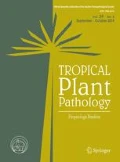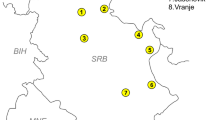Abstract
Liquidambar styraciflua was introduced in Bogotá (D. C.) Colombia, in the 1990s as an urban tree. Yellowing and deformation of the tree crowns began to appear in 2007, leading to the hypothesis of a possible phytoplasma infection. To detect and identify phytoplasmas, samples were collected from 21 liquidambar trees from Bogota in 2009, 2010 and 2011 and subjected to nested PCR, RFLP and sequencing analyses of 16S ribosomal DNA. Nested PCR assays with group-specific primers and RFLP analyses identified phytoplasmas belonging to the 16SrI-B (aster yellows), 16SrV-B (jujube witches’ broom), 16SrVII-A (ash yellows), 16SrIX (pigeon pea witches’ broom) and 16SrXII-A (“stolbur”) groups/subgroups, in single or mixed infections. Sequence analysis and phylogenetic evaluation of samples with single phytoplasma infections confirmed the presence of phytoplasmas related to ‘Candidatus Phytoplasma asteris’, ‘Ca. P. fraxini’, and ‘Ca. P. solani’. In 2010 and 2013 two further surveys involving 100 trees each time were carried out to estimate the prevalence of the disease: the average prevalence with severe symptoms was 28%, with mild symptoms, 56%, and with minor symptoms 16% of the trees. No symptomless trees were observed. Phytoplasma presence in liquidambar trees from Bogota carries economic, environmental and epidemiological consequences, and urgent measures should be implemented to avoid the spreading of the disease to other tree species and to the agricultural areas surrounding the city.



Similar content being viewed by others
References
Alma A, Davis RE, Vibio M, Danielli A, Bosco D, Arzone A, Bertaccini A (1996) Mixed infection of grapevines in northern Italy by phytoplasmas including 16S rRNA RFLP subgroup 16SrI-B strains previously unreported in this host. Plant Disease 80:418–421
Alvarez E, Mejia JF, Llano GA, Loke JB, Calari A, Duduk B, Bertaccini A (2009) Detection and molecular characterization of a phytoplasma associated with frogskin disease in cassava. Plant Disease 93:1139–1145
Alvarez E, Mejia JF, Contaldo N, Paltrinieri S, Duduk B, Bertaccini A (2014) ‘Candidatus Phytoplasma asteris’ strains associated with oil palm lethal wilt in Colombia. Plant Disease 98:311–318
Bertaccini A, Duduk B (2009) Phytoplasma and phytoplasma diseases: a review of recent research. Phytopathologia Mediterranea 48:355–378
Bertaccini A, Carraro L, Davies D, Laimer da Câmara Machado M., Martini M, Paltrinieri, S, Seemüller E (2000). Micropropagation of a collection of phytoplasma strains in periwinkle and other host plants. 13th Congress IOM, Fukuoka, July 14–19, 2000, pp 101
Bertaccini A, Duduk B, Paltrinieri S, Contaldo N (2014) Phytoplasmas and phytoplasma diseases: a severe threat to agriculture. American Journal of Plant Sciences 5:1763–1788
Boa E (2003) An illustrated guide to the state of health of trees. Recognition and interpretation of symptoms and damage. London, CABI Bioscience
Bricker JS, Stutz JC (2004) Phytoplasmas associated with ash decline. Journal of Arboriculture 30:193–198
Calari A, Paltrinieri S, Contaldo N, Sakalieva D, Mori N, Duduk B, Bertaccini (2011) Molecular evidence of phytoplasmas in winter oilseed rape, tomato and corn seedlings. Bulletin of Insectology 64:S157–S158
Contaldo N, Bertaccini A, Paltrinieri S, Windsor HM, Windsor D (2012) Axenic culture of plant pathogenic phytoplasmas. Phytopathologia Mediterranea 51:607–617
Contaldo N, Satta E, Zambon Y, Paltrinieri S, Bertaccini A (2016) Development and evaluation of different complex media for phytoplasma isolation and growth. Journal of Microbiological Methods 127:105–110
Davis E, Harrison NA, Zhao Y, Wei W, Dally EL (2016) ´Candidatus Phytoplasma hispanicum´, a novel taxon associated with Mexican periwinkle virescence disease of Catharanthus roseus. International Journal of Systematic and Evolutionary Microbiology 66:3463–3467
Fernandez FD, Galdeano E, Kornowski MV, Arneodo ID, Conci LR (2016) Description of ‘Candidatus Phytoplasma meliae’, a phytoplasma associated with chinaberry (Melia azedarach L.) yellowing in South America. International Journal of Systematic and Evolutionary Microbiology 66:5244–5251
Filgueira JJ, Franco-Lara L, Salcedo JE, Gaitan SL, Boa ER (2004) Urapán (Fraxinus udhei) dieback, a new disease associated with a phytoplasma in Colombia. Plant Patholology 53:520
Franco-Lara L, Filgueira JJ (2005) Síntomas de decaimiento del Urapán (Fraxinus sp.) en Colombia. Fitopatología Colombiana 29:32–38
Franco-Lara L, Perilla Henao LM (2014) Phytoplasma diseases in trees of Bogotà, Colombia: a serious risk for urban trees and crops. In: Bertaccini A (ed) Phytoplasmas and phytoplasma disease management: how to reduce their economic impact. IPWG - international Phytoplasmologist working group, COST Action FA0807, Bologna, pp 90–100
Galvis CA, Leguizamon JE, Gaitan AL, Mejia JF, Alvarez E, Arroyave J (2007) Detection and identification of a 16SrIII-related phytoplasma associated with coffee crispiness disease in Colombia. Plant Disease 91:248–252
Gibb KS, Padovan AC, Mogen BD (1995) Studies on sweet potato little-leaf phytoplasma detected in sweet potato and other plant species growing in northern Australia. Phytopathology 85:169–174
Gundersen D, Lee I-M (1996) Ultrasensitive detection of phytoplasmas by nested-PCR assay using two universal primer pairs. Phytopathologia Mediterranea 35:144–151
Habili N, Farrokhi N, Randlesa JW (2007) First detection of ‘Candidatus Phytoplasma australiense’ in Liquidambar styraciflua in Australia. Plant Pathology 56:346
Hall TA (1999) BioEdit: a user-friendly biological sequence alignment editor and analysis program for windows 95/98/NT. Nucleic Acids Symposium Series 42:95–98
Ickert-Bond SM, Wen J (2013) A taxonomic synopsis of Altingiaceae with nine new combinations. PhytoKeys 31:21–61
IRPCM (2004) ‘Candidatus Phytoplasma’, a taxon for the wall-less, non-helical prokaryotes that colonize plant phloem and insects. International Journal of Systematic and Evolutionary Microbiology 54:1243–1255
Lee I-M, Gundersen DE, Hammond RW, Davis RE (1994) Use of mycoplasmalike organism (MLO) group-specific oligonucleotide primers for nested-PCR assays to detect mixed-MLO infections in a single host plant. Phytopathology 84:559–566
Lee I-M, Gundersen-Rindal DE, Davis RE, Bartoszyk IM (1998) Revised classification scheme of phytoplasmas based on RFLP analyses of 16s rRNA and ribosomal protein gene sequences. International Journal of Systematic and Evolutionary Microbiology 48:1153–1169
Lee I-M, Davis RE, Gundersen-Rindal DE (2000) Phytoplasmas: phytopathogenic Mollicutes. Annual Review Microbiology 54:211–255
Lee I-M, Gundersen-Rindal DE, Davis RE, Bottner KD, Marcone C, Seemüller E (2004) ‘Candidatus Phytoplasma asteris’, a novel phytoplasma taxon associated with aster yellows and related diseases. International Journal of Systematic and Evolutionary Microbiology 54:1037–1048
Mejia JF, Paltrinieri S, Rincon E, Ospina CM, Gaitan A, Pardo JM, Alvarez E, Bertaccini A (2014) Coffee crispiness and nogal cafetero witches’ broom associated with ‘Candidatus Phytoplasma pruni’-related strains in Colombia: multilocus gene characterization. In: Bertaccini A (ed) Phytoplasmas and phytoplasma disease management: how to reduce their economic impact. IPWG - international Phytoplasmologist Working group, Bologna, Cost FA0807, pp 101–108
Olivier CY, Galka B, Séguin-Swartz G (2010) Detection of aster yellows phytoplasma DNA in seed and seedlings of canola (Brassica napus and B. rapa) and AY strain identification. Canadian Journal of Plant Pathology Pathol 32:298–305
Oropeza C, Cordova I, Puch-Hau C, Castillo R, Chan JL, Sáenz L (2017) Detection of lethal yellowing phytoplasma in coconut plantlets obtained through in vitro germination of zygotic embryos from the seeds of infected palms. Annals of Applied Biology doi:10.1111/aab.12351
Perilla LM, Dickinson M, Franco-Lara L (2012) First report of 'Candidatus Phytoplasma asteris' affecting woody hosts (Fraxinus uhdei, Populus nigra, Pittosporum undulatum and Croton spp.) in Colombia. Plant Disease 96:1372
Perilla-Henao LM, Franco-Lara L (2013) Especies arbóreas de las familias Euphorbiaceae, Pittosporaceae y Salicaceae son infectadas por ‘Ca. Phytoplasma fraxini’ y ‘Ca. Phytoplasma asteris’ en infecciones mixtas en Bogotá, Colombia. Revista Facultad de Ciencias Básicas 9:248–265
Perilla-Henao LM, Wilson MR, Franco-Lara L (2016) Leafhoppers Exitianus atratus and Amplicephalus funzaensis transmit phytoplasmas of groups 16SrI and 16SrVII in Colombia. Plant Pathology 65:1200–1209
Plant Fact Sheets, USDA NRCS nd (2014) Liquidambar styraciflua L., viewed 12 September 2014, http://plants.usda.gov/plantguide/pdf/cs_list2.pdf
Prince JP, Davis RE, Wolf TK, Lee I-M, Mogen BD, Dally EL, Bertaccini A, Barba M (1993) Molecular detection of diverse mycoplasmalike organisms (MLOs) associates with grapevine yellows and their classification with Aster yellows, X-disease, and elm yellows MLOs. Phytopathology 83:1130–1137
Seemüller E, Schneider B, Maürer R, Ahrens U, Daire X, Kison H, Lorenz KH, Firrao G, Avinent L, Sears BB, Stackebrandt E (1994) Phylogenetic classification of phytopathogenic mollicutes by sequence analysis of 16S ribosomal DNA. International Journal of Systematic and Evolutionary Microbiology 44:440–446
Serrone P, Marzachì C, Bragaloni M, Galeffi P (2001) Phytoplasma infection of tomato in central, Italy. Phytopathologia Mediterranea 40:137–142
Sinclair WA, Griffiths HM (1994) Ash yellows and its relationship to dieback and decline of ash. Annual Review of Phytopathology 32:49–60
Sinclair WA, Griffiths HM, Davis RE (1996) Ash yellows and lilac witches´ broom: phytoplasmal diseases of concern in forestry and horticulture. Plant Disease 80:468–475
Tamura K, Peterson D, Peterson N, Stecher G, Nei M, Kumar S (2011) MEGA5: molecular evolutionary genetics analysis using maximum likelihood, evolutionary distance, and maximum parsimony methods. Molecular Biology and Evolution 28:2731–2739
Thompson JD, Gibson TJ, Plewniak F, Jeanmougin F, Higgins DG (1997) The CLUSTAL X windows interface: flexible strategies for multiple sequence alignment aided by quality analysis tools. Nucleic Acids Research 25:4876–4882
Wei W, Davis RE, Lee I-M, Zhao Y (2007) Computer-simulated RFLP analysis of 16S rRNA genes: identification of ten new phytoplasma groups. International Journal of Systematic and Evolutionary Microbiology 57:1855–1867
Weintraub PG, Beanland L (2006) Insect vectors of phytoplasmas. Annual Review Entomology 51:91–111
Zhao Y, Wei W, Lee I-M, Shao J, Suo X, Davis RE (2009) Construction of an interactive online phytoplasma classification tool, iPhyClassifier, and its application in analysis of the peach X-disease phytoplasma group (16SrIII). International Journal of Systematic and Evolutionary Microbiology 59:2582–2593
Zhu SF, Hadidi A, Lee I-M, Gundersen DE, Zhang CL (1997) Characterization of the phytoplasmas associated with cherry lethal yellows and jujube witches’ broom disease in China. Acta Horticulturae 472:701–714
Acknowledgements
The authors thank Carlos A. Martinez and Andrea Escandon for their work as part of the research group. Funds for this research were provided by the Vicerrectoría de Investigaciones of Universidad Militar Nueva Granada, under grant CIAS 550.
Author information
Authors and Affiliations
Corresponding author
Additional information
Section Editor: Luis Rogelio Conci
Rights and permissions
About this article
Cite this article
Franco-Lara, L., Contaldo, N., Mejia, J.F. et al. Detection and identification of phytoplasmas associated with declining Liquidambar styraciflua trees in Colombia. Trop. plant pathol. 42, 352–361 (2017). https://doi.org/10.1007/s40858-017-0170-4
Received:
Accepted:
Published:
Issue Date:
DOI: https://doi.org/10.1007/s40858-017-0170-4




